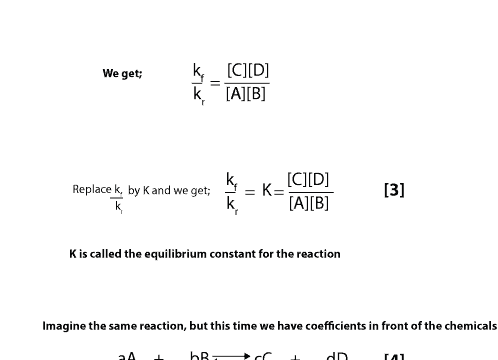Reactions reach chemical equilibrium when the rate of the forward reaction is equal to the rate of the backward reaction. To further explain this, let’s say chemical A reacts with chemical B to form chemical C and D. We can write the reaction’s equation as: A + B → C + D. Since A reacts with B to make C and D, C can also react with D to get back A and B. We can write the reaction’s equation as: C + D → A + B.
From these two equations, you will notice that chemical reactions can go forward and backward. The reaction in which reactants are converted to products (A + B → C + D) is called the forward reaction, while the reaction in which products are converted back to reactants (C + D → A + B) is called the reverse reaction.
Usually, the forward reaction must start, before the products can appear. As a result, the reverse reaction’s rate starts off at zero. However, as C and D begin to appear, and their concentration build up, the rate of the reverse reaction gradually picks up speed, while the rate of the forward reaction slows. This slowness is caused by a decrease in the concentration of A and B. This happens because the reaction must consume A and B to make C and D.
As the reaction continues, it gets to a point where the rate at which A and B react to form C and D is equal to the rate at which C and D react to form back A and B. When this point is reached, the reaction is in a state called dynamic chemical equilibrium. Dynamic in the sense that the forward and reverse reactions are continually occurring with no net increase or decrease in the concentration of reactants and products. As an analogy, you can imagine dynamic chemical equilibrium as a tug-of-war between you and your friend with no one having the urge to pull the other to his or her side. Here is a graph illustrating the forward rate, reverse rate, and chemical equilibrium.

From the graph, you can see that the reverse rate starts off at zero, while the forward rate does not.
Since we know that chemical reactions can go forward and backward, we can now combine these two reactions into one equation with a double arrow between the reactants and products. Here is the equation with one arrow pointing to the right (forward reaction) and the other arrow pointing to the left (reverse reaction).

From experiments, the rate of reaction is directly proportional to the reactants concentration. Therefore, we can express the rate of the forward reaction as:
- Forward rate ∝ [A][B]. We can remove the proportionality sign and introduce an equal sign and a proportionality constant, k. When we do, we can rewrite the expression as:
Forward rate = kf[A][B], where kf is the rate constant for the forward reaction
Similarly, we can express the rate of the reverse reaction as:
- Reverse rate = kr[C][D], where kr is the rate constant for the reverse reaction.
At equilibrium, the rate of the forward reaction is equal to the rate of the reverse reaction. Therefore, we can write that: kf[A][B] = kr[C][D]. If we divide both sides of the equation by
[A][B] kr, we will get the result in 2 below.

From equation 3, you will notice that the equilibrium constant, K is the result of dividing the rate constant of the forward reaction by the rate constant of the reverse reaction. Usually, we can calculate the equilibrium constant if we know the values of all the other quantities in the expression. The equilibrium constant is a number whose value depends on temperature.
On the other hand, if the balanced equation for the reaction has coefficients in front of the chemicals, then, we will write the expression like the one in [5]. As you will notice, the coefficients from the equation become the superscripts (exponents) in the equilibrium expression.
From the expression in 5, we can deduce that the larger the value of K, the greater the concentration of products. This makes sense because to get K we must divide the concentration of the products by the concentration of the reactants.
